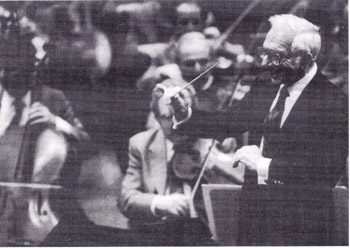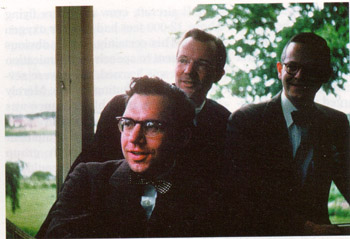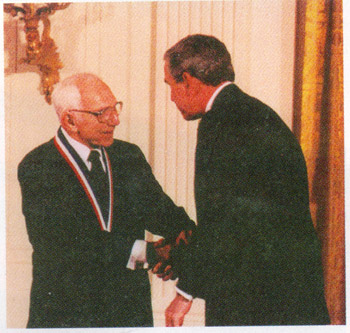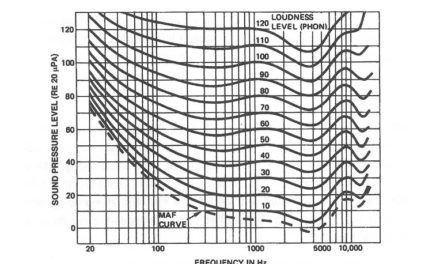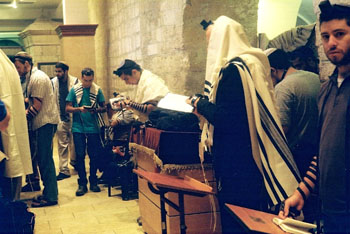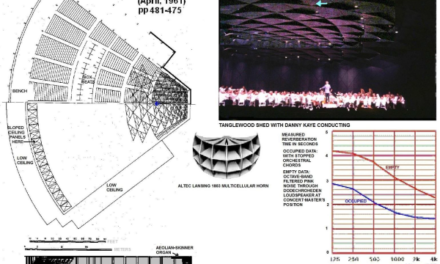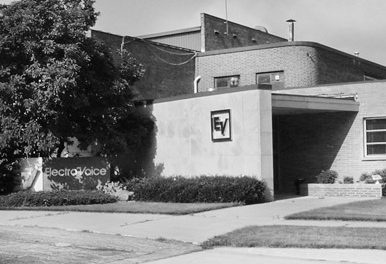By R. David Read
Originally Published in Sound & Communications, June 2004
Editor’s Note: Courtesy of Sound & Communications Magazine, your Pro Audio Encyclopedia is pleased to republish this in-depth biography of industry pioneer Dr. Leo L. Beranek authored by R. David Read. Read, who passed away in April of 2015, was the author of Sound & Communications’ popular series about Industry Pioneers and a well-known technical writer and history buff. A biography of R. David Read can be found here.
Of special note, Leo Beranek celebrated his 100th birthday on August 25th, 2014.
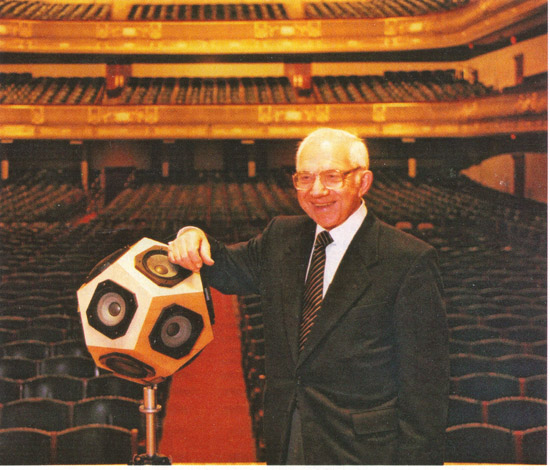 Figure 1: Beranek in Boston Symphony Hall with his sound measuring device.
Figure 1: Beranek in Boston Symphony Hall with his sound measuring device.
Dr. Leo L. Beranek (1914- ) the oldest son of Edward & Beatrice Beranek, was raised near Solon IA, a small rural town with a large Czech/German population near Iowa City. The young Beranek took an early interest in electromechanical devices and when his father purchased the family’s first one-tube Crosley radio in 1923, the youngster’s interest in radio was kindled. He relates, “I strung an antenna between a distant tree and the house, and spent many of my evenings attempting to tune in distant radio stations.”
In 1926, the Beranek family moved to Mt. Vernon IA, not far from Cedar Rapids, where his father entered into a partnership with his cousin in a hardware store appropriately called Beranek Hardware. Along with general hardware items and farm machinery, the store also sold radios that, of course, had to be installed and sometimes repaired.
To perform those services, the store hired a third-year student from the local liberal-arts school, Cornell College of Iowa.
Beranek’s interests in radio had not faltered and, while still a sophomore in high school, his father enrolled him in a correspondence course on the subject of radio. The elder Beranek also arranged for his son to serve as an unpaid apprentice to the firm’s radio repairman. Given the combination of his correspondence training and the on-the-job experience as a gofer, he soon became adept at repairing radios; when the Cornell College student finished school and left Mt. Vernon, the high-school senior assumed the role of radio serviceman for Beranek Hardware.
Figure 2: Beranek Conducted the Boston Symphony Orchestra in Boston Symphony Hall at a sold-out Pops concert in 1994. He conducted “The Stars and Stripes Forever” after asking for the opportunity to learn how the acoustics of a hall are perceived at the conductor’s position.
Music Appreciation
While still in grade school, Beranek had been introduced to the piano and learned to read music. When he entered high school, the band needed musicians and, as he states, “My music teacher recommended the trombone: I didn’t like it. Then [the teacher] suggested a bass horn. My grandmother didn’t like that, so finally I took up drums and played in the school band.” When the family moved to Mt. Vernon, Beranek was recruited by a local band leader and played at some dances to bolster his meager income as the local radio repairman.
His former mentor in the radio business was from Chicago and played his 78rpm record collection of opera selections performed by the Chicago Lyric Opera Company during their radio repair sessions. Beranek attributed that exposure, at least in part, to his undying appreciation for good music. Later, during his college years at Cornell, he played drums in the band and tympani in the orchestra.
Depression Years
As with so many of his generation, the Great Depression was a terrible disruption. His father sold his interest in the hardware store and eventually lost the balance of his savings when his bank failed. Leo, just on the verge of entering Cornell College as a freshman, recalled that, “In the middle of August 1931, I had saved a little over $400 from my radio repair business and my dance band playing. I decided to remove $400 from my savings to pay my first year’s tuition at college: When I walked in to make my withdrawal, the teller called in her manager. He asked what I wanted the money for. I explained it was for my college tuition. He responded, ‘If you wanted it for any other purpose, I would not give it to you.’ The very next morning, that bank failed and I lost the balance of my account.”
Although his family had moved to Cedar Rapids, young Beranek continued his plan to enroll in Cornell College majoring in mathematics and physics. And, by playing in the local dance band, repairing radios and skimping on his lodgings, he was able to pay his tuition and meet his living expenses. However, by mid-term in his junior year at Cornell, he was unable to make ends meet and was forced to drop out of college and seek full-time employment.
Collins Radio Epic
The Collins Radio Company was located about 16 miles away in Cedar Rapids, and was a recognized and stable manufacturer of radio transmitters. Leo sent Arthur Collins a letter asking for employment. He was hired and set to work accompanying a salesman responsible for selling and installing sound systems-particularly in funeral homes. After several months, he grew bored and approached Collins for a more challenging position. The upshot was appointment as a technician in the engineering department.
Recalling one incident related to his days at Collins, Beranek remembers when the Collins Engineering Department developed its first 1000 watt amateur band transmitter. Arthur Collins, being an avid amateur, was anxious to try out the new rig. “I set up the equipment, which was about the size of three of today’s refrigerators in Arthur’s office and was standing by when he went on the air with a ‘CQ’ call (seeking you to talk to). His call was answered almost immediately by a fellow ‘ham’ in Mexico City. The fellow said, ‘You’re coming in loud and clear. What kind of a rig do you have?’. Arthur chortled and replied that it was just something they had thrown together; he failed to mention that it [the transmitter] was then one of the most powerful amateur radio transmitters in existence.”
Of his days at Collins, Beranek makes mention that he had the opportunity to work with some brilliant engineers and also received a valuable lesson in the wherewithal that came from observing the operation of a high-tech business in a competitive environment. In 1935, Arthur’s father, M.H. Collins, convinced the young aspiring technician that a future in radio engineering was dependent on a college education and some graduate work in the field. Leo then returned to Cornell College and resumed his education.
It Pays to Change a Tire
By repairing radios, playing drums in a dance band and wiring houses in response to the government-sponsored REA (Rural Electrification Administration), Leo was able to make his living expenses and save toward tuition for graduate school. Realizing that his meager savings wouldn’t go far, he banked his hopes on receiving a scholarship from one of the Midwest schools. “Then,” as he relates, “came my big break.”
On a blistering hot Iowa summer afternoon, the young Beranek was walking down the main street in Mt. Vernon when he chanced upon a Cadillac sedan with a flat tire and a distraught, well-dressed man musing on his dilemma. Leo offered his assistance, which was accepted gratefully. Afterward, the car’s driver and his benefactor started talking. “He asked my name and what I did, and I explained my plans to seek a scholarship to attend graduate school.
“Upon learning of my interest in radio, he introduced himself as Glenn Browning, one of the leading radio engineers in the Boston area. He suggested that I apply to his alma mater: Harvard. I had never even considered applying to such a rich and prestigious institution.” Browning offered his name as a reference. The upshot was that his application for a scholarship to Harvard was accepted. Beranek’s motto even to today is, “Don’t pass up a chance to change a tire.”
Harvard Days
Arriving in Cambridge, Beranek was pleased that his fundamental education at Cornell College served him well; his first year’s grades consisted of a solid string of As. Assigned to Cruft Laboratory, which was at the time a sort of “halfway” house between engineering and physics, Beranek notes that during his time there, instructors were given the title of Professor of Physics and Communication Engineer. Hence, pure applied physics was tempered with the practical application of what we might today refer to as Electronic Science.
Intro to Acoustics
After a difficult first year during which his economic resources dwindled away, he was approached to become an assistant to the famed acoustician Frederick V. Hunt. The arrangement was such that Beranek would work half-time for Hunt and devote the other half of his time to his graduate studies. Leo was greatly relieved and notes that “I now had a decent half-time salary and could return to eating three meals a day.”
Hunt was at the time immersed in developing a light-weight phonograph pickup that could be used for playback from vinyl records. Beranek worked to design and construct a high-quality sound playback system. Because many of the components that Hunt had specified were not available, it fell to Beranek to design and then fabricate the required devices.
Professor Hunt was also involved in architectural acoustics and became interested in investigating the theories as presented by Dr. Phillip Morse of MIT on the acoustical properties of sound in larger acoustical spaces. Beranek’s role was to condition the test room with varying types and quantities of acoustical materials and then measure the response to verify whether the calculated values conformed to the measured data.
In this pursuit, he was joined by another graduate student named Maa Dah-Yuh from the University of Peking. Working under Hunt, they proved and expanded on Morris’ theories and jointly published “Acoustical Analysis of Sound Decay in Rectangular Rooms” in the Journal of the Acoustical Society of America, JASA (July, 1939).
Figure 3: In the Spring of 1951, Robert B. Newman (right) was admitted to the Bolt (left rear) Beranek (front) partnership, resulting in the creation of Bolt Beranek and Newman.
By now, Beranek was thoroughly intrigued with acoustical matters. Probably at the recommendation of Hunt, he was awarded Harvard’s prestigious Parker Fellowship. By the terms of the Fellowship, he could study full-time, travel anywhere in the world to study and was endowed with a generous amount of money. Due to the then raging war in Europe, the travel aspects were curtailed severely; however, it provided him with the latitude to devote full-time to his Doctoral Thesis on the subject of measuring acoustical properties of absorption materials in rooms. He comments that his studies were really a combination of electrical engineering and acoustical science, inasmuch as many of the measuring devices he proposed had to be developed from scratch. In that respect, his training in radio engineering was to prove invaluable.
Beranek received his D.Sc. in June 1940.
The War Years
Almost immediately after Beranek received his doctorate, the US military launched a nationwide program in the fields of defense research. After a somewhat contentious political turf war between Harvard and MIT regarding which institution would receive the funding and recognition associated with the founding of the National Defense Research Committee (NDRC), the 26-year-old Beranek eventually was chosen to head the new Harvard-based research effort. He directed what was Harvard’s first government-funded, research-project contract. Without any previous experience, he was charged with establishing and equipping a testing laboratory; recruiting the necessary qualified personnel and managing the financing for the new agency. The lessons he had learned related to administration at Collins Radio back in Cedar Rapids became extremely valuable.
The first order of business was to investigate how acoustical treatment within aircraft could reduce the noise fatigue that was plaguing B-17 aircraft pilots. The US government was “lend-leasing” bombers to the British for sorties over Germany and the Army Air Corps was well aware of the noise in aircraft cockpits. At initial glance, it seemed that reducing noise within an aircraft would be a simple acoustical solution; however, it turned out to be anything but simple.
First Step
The first step was to quantify the problem by making multiple measurements of the offending noises. Beranek notes, “Quiet for the pilots was the big goal, but they had windows all around; the sides of the cockpit were covered with radio and navigation equipment, and there were no exposed areas for [the application of] acoustical treatment.” The subsequent report from the Harvard group was to the effect that, although acoustically reducing noise in such an environment was feasible for new aircraft, retrofitting older models probably was not feasible. Beranek summarized that the primary value of their studies provided valuable information about how to build the passenger airplanes that would be forthcoming after the cessation of hostilities.
The second problem presented to Beranek’s group was a direct outgrowth of the previous studies: how to improve voice communication between airborne aircraft crew members and air-to-ground radio transmissions. In the unpressurized cabins of World War II aircraft, crew members flying above 12,000 feet had to wear oxygen masks. This certainly was an obvious impediment to speech communication but, as it was learned, there were several other contributing factors. Merely improving the available ordnance was not the sole solution. Using available hardware and subsequent equipment improvements, the research group began collecting data that could be analyzed by the Psycho-Acoustics Lab (PAL) directed by S.S. Stevens. J.C.R (Lick) Licklider was a senior member of PAL and that group worked closely with Beranek’s Electro-Acoustic Lab (EAL). More will be heard about Lick Licklider later.
Little Had Been Done
Little, if anything, had been done toward investigating the effect of high altitude speech transmission. Bell Labs had done some work on speech and hearing apparatus (see “Audio Pioneers Part 3, Dr. Harvey Fletcher,” Sound & Communications, October 2000), but these tests had been performed at sea level. Consequently, virtually nothing was known about performance of these devices at altitudes or in the acoustically noisy environments prevalent in military aircraft, or about the weakening of the human voice in rarefied atmospheres. Beranek’s Harvard Group was essentially the only research facility in the world devoted to such studies. The resultant tests on both the hardware and psycho-acoustic analysis prompted recommendations for several modifications to existing materials and the adoption of altogether new devices to combat the problem.
EAL quickly encountered the bureaucratic obstacles prevalent in the adoption of new systems by the military. Much like Kahn at EV (see “Audio Pioneers Part 10, Albert R. Kahn,” Sound & Communications, March 2004) Beranek and his group found it necessary to bulldoze their way into paperwork mountains to achieve adoption of their recommended improvements. That their efforts were successful is demonstrated by the fact that the new equipment was on its way to British manned B-17s within a matter of months. By 1943, all major airborne vehicles were thusly equipped.
Another Challenge
Then came another challenge: Kamikazes were raising havoc with US warships in the Pacific Sector. Radar aboard US warships was limited in detection of low-flying attack aircraft, and communication coordination between the shipboard command centers (CICs) and gunnery positions compounded the problem. The common expression of the day was that the best defense against a Kamikaze airplane was a Marine on deck with an M-1 rifle. To devise a solution, Beranek was asked to set up a landbased facility, which was dubbed the SRL (Systems Research Laboratory). The new entity needed a land-based facility that would replicate a naval vessel. A single-story “superstructure” that would have a clear radar sweep of the horizon was built in record time on a spit of land in Narragansett Bay called Beavertail Point.
An immediate problem was encountered in the face of Navy directives that forbade deployment of new equipment to any land-based facility: All such equipment was to be sent to the fleet where it was desperately needed. The problem was solved when the Navy informally commissioned Beranek’s Lab as the USS Beavertail.
With the new “ship” under construction and being equipped with the latest radar equipment, Beranek and his lab associates went to sea to study the operations of the existing CIC facilities. By the time the SRL site was completed, a great deal of data had been collected and tests were conducted by having a squadron of aircraft repeatedly “mock-attack” the USS Beavertail. Through these endeavors, enough was learned to suggest improvements that would improve equipment placement, utilization and communication procedures aboard ships. Almost to the day when the final report was to be presented and modification orders implemented, President Truman decided to approve the dropping of the atomic bomb. The war was over and the USS Beavertail was decommissioned.
Independent Consulting
By 1947, Dr. Beranek had moved to MIT (Massachusetts Institute of Technology). After the war, MIT had greatly expanded its acoustical research facilities and had become one of the leading research and teaching laboratories in the field. Accordingly, many architects came to regard MIT as the place-to-go when searching for consultation in acoustics.
When the New York City-based architectural firm of Harrison and Abramovitz was selected as the lead architects for the newly planned permanent headquarters for the United Nations, the company sent a solicitation to MIT. The matter was referred to Physics Professor Richard H. (Dick) Bolt and his proposal was subsequently accepted. When Bolt began reviewing the scope of the project, he realized it was way too large to be handled by one person and he approached Beranek to join him in the endeavor. The two associates had kept University President Killian apprised of their situation and Killian suggested they set up an independent consulting firm; Killen reiterated that MIT was not interested in getting into the consulting business. Hence, the firm of Bolt and Beranek was formed in November of 1948.
Founding of BBN
Within a short time, the fledgling firm expanded rapidly. Bolt and Beranek invited Robert B. (Bob) Newman (see “Audio Pioneers Part 11, Dr. C.P. Boner,” Sound & Communications, April 2004) to join them and the firm became the partnership of Bolt Beranek and Newman (BBN). It was a fortuitous arrangement, in that Bolt was a physicist, Beranek was an EE and Newman held a degree in architecture. They had already outgrown the rented space provided by MIT and had moved to larger quarters in Harvard Square.
As the stature and reputation of BBN grew in the field of architectural acoustics, the firm began to receive commissions from music halls, auditoriums, convention centers and commercial building projects. Offices were established in Los Angeles, Houston, Chicago, New York and Washington DC. During the 1950s and 1960s, BBN was the preeminent architectural acoustical firm in the nation. As such, it proved to be a mentoring and training ground for an entire generation of acoustical consultants.
BBN was incorporated in 1953 and Dr. Beranek was appointed as the firm’s first president. Few success stories are void of blemishes and BBN was no exception. BBN’s involvement in the ill-fated Lincoln Center was, through no fault of its own, a comedy of errors that nevertheless tarnished (albeit temporarily) its reputation. There is scant space here to document the problems surrounding this project. Dr. Beranek stated the facts quite saliently in a paper that compared the circumstances surrounding Lincoln Center with the much more successful Tokyo Opera City National Theatre.
Paraphrasing Beranek, the simple facts included lack of committed money, lack of direction, absence of focus and poor communication between the client, the architect and the consultant. Toss in the vituperative comment of the critics from the New York newspapers about an acoustical disaster even prior to the opening and you have a badly stacked deck. Despite this singular episode, BBN went on to produce countless properties that provided testimony to the company’s expertise.
Noise, Vibration Control
Perhaps allied to, but somewhat distinct from architectural acoustics, was the firm’s involvement in noise and vibration control. As noted earlier, Beranek had become familiar with aircraft noise control during his wartime days at EAL; this led to BBN assignments in the field of reducing noise in jet engines and environmental surroundings. In a paper, “Shoe-Horning in the Jet Age,” presented at the ASA in November 2003, Beranek stated that the largest contribution BBN made to the “welfare of mankind” was the company’s assistance to the Port of New York Authority (PNYA) in the late 1950s with regard to quieting jet noise from Idlewild (now JFK) airport in New York City.
Faced with the specter of irate citizens protesting the impending noise and pushing baby carriages down the runways at the airport, the Port Authority panicked, according to Beranek. Tests were ordered to determine if the proposed new Boeing 707s would be nosier than Lockheed Super Constellations. BBN accepted the assignment and, even in the face of rants and protestations by irate aircraft manufacturers and some severe political pressure, the firm assisted the PNYA in crafting regulations and modifications to aircraft that would be acceptable to local residents. BBN’s recommendations resulted in regulations that mandated the use of jet engine mufflers and prescribed take-off procedures for jet equipped aircraft.
Other Pursuits
Certainly, BBN had attained a position of eminence in architectural acoustics and noise and vibration control by the 1960s. However, Beranek as a visionary was concerned about what future developments might impact the organization. Reenter Lick Licklider from the PAL operation at. Harvard during the war years. In the decade between the end of World War II and the introduction of rudimentary computer science in the early 1960s, Licklider (as an early constituent of what was to become ARPA) had reached the conclusion that future scientific research was going to be linked to high-speed computers and he espoused the idea that BBN should be a major contributor. Beranek was dubious, but authorized $25,000 (1958 dollars) to purchase an unknown machine that was to yet be utilized for an unknown purpose: He blamed his impetuous decision on the fact that, “I had the utmost confidence in Lick.”
This was at a time when long-distance computer networking was basically non-existent. The US Department of Defense had barely had time to establish its Advanced Research Projects Agency, which morphed into ARPA; this eventually spawned the perhaps more familiar network called ARPANET.
BBN was an early player in the adoption of time-sharing domain. Much of this element of Beranek’s endeavors are covered in the book, Where Wizards Stay Up Late-The Origins of the Internet (in which, rather conspicuously, former Vice President Al Gore is not mentioned). Needless to say, BBN was a prime contributor toward the development of the ARPANET, which was the forerunner of what we know today as the World Wide Web.1
At this point, the architectural acoustics portion of BBN took a decidedly divergent path from the computer development aspects. Just as BBN was deeply involved in such esoteric projects as underwater acoustics for submarines, jet engine analysis and spacecraft hydrophone research, a core element of the firm remained dedicated to the pure physics of applied acoustical solutions for architectural spaces. Beranek often stated, “At heart, I am an acoustician foremost.”
Figure 4: In November 2003, Beranek received the National Medal of Science from President George W. Bush in the East Room of the White House before a gathering of 200.
Change of Pace
In 1971, after 16 years heading BBN, Beranek resigned to devote his attention to the operations as president and CEO of WCVB-TV, Boston’s Channel 5 ABC outlet. Beranek explains, “I was basically an acoustician. BBN was getting to be more of a computer company, and I was not particularly comfortable with the concept of dealing with a publicly traded (NASDAQ) entity. So, I headed off into an entirely different pursuit.”
He maintained his position as president of the TV corporation and chairman of the board at WCVB for nine years, and remained on as chairman for an additional two years. During that time, the station received numerous accolades for innovative and newsworthy programming. Beranek notes, ”We were one of the best things on the air.”
Following his presidency of Channel 5, Beranek served on the Board of Directors and part-time consultant for now forgotten Wang Laboratories. Beranek laments, ‘They missed the advent of the PC computer and at that point, Wang was finished.” He relates an interesting story involving Dr. An Wang of Wang Laboratories. When asked to look at a new computer concept called Apple, Wang responded, “Take it away, I don’t want to look at a toy.” Beranek adds, “He made a judgment call that was to foretell the demise of his company.”
At that point, in time, Beranek turned his attention to cultural activities and served as chairman of the Boston Symphony Orchestra (1983-1987); president of the American Academy of Arts and Sciences (1989-1994) and member of the Board of Overseers of Harvard University from 1984-1990.
Acoustician’s Rebirth
Perhaps “rebirth” is a misnomer, as Beranek was always a devoted adherent to acoustical matters. During his career, he has published nine books, all of which are related to acoustical matters and all but one of which have been translated into numerous languages and remain in print.
Following his experiences in computer development and broadcasting, Dr. Beranek once again turned his attention to consulting in architectural acoustics. In that regard, his reputation has spread worldwide due to commissions in such renowned facilities as the Koussevitzky Music Shed at Tanglewood, the Hammarikyu-Ashai and Mitaka Concert Halls in Tokyo; Aula-Magna in Caracas (Venezuela); Binyanei Ha’Oomah Convention Center- Concert Hall in Jerusalem, Israel and, his most recent accomplishment, at the concert hall and opera house in the Tokyo Opera City Center.
Accolades
Dr. Leo Beranek is a fellow of the ASA, a past president of the Society, a Fellow of the AES, a recipient of both the Wallace C. Sabine Medal and the ASA’s Gold Medal. AES has equally honored him by bestowing its prestigious Gold Medal. In the fall of 2003, Dr. Beranek was presented with the National Medal of Science. At that time, President Bush complimented him for his leadership, dedication and contributions to the art and science of acoustics, for co-founding one of the world’s foremost acoustical research and consulting firms, and for sustained contributions to scientific and civic organizations.
Still very active in the ASA, Leo (as he is known to his friends and colleagues) is a frequent presenter and participant in the Society’s activities. A more gracious and accommodating individual one seldom encounters.
References
- The full story of the development of the Internet, from the founding of ARPA to what is now the familiar World Wide Web, and BBN’s involvement therein can in no way be traced in an article of this length. For additional information: Abbate, Janet, Inventing the Internet, MIT Press, Cambridge MA 2000; ISBN 0-262-01172-7.

